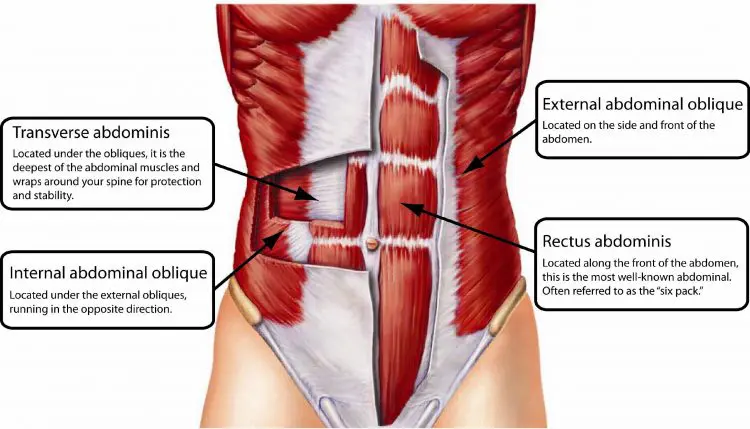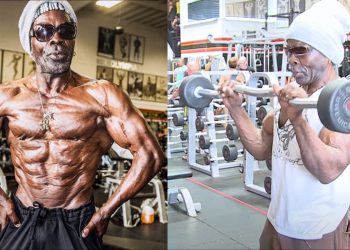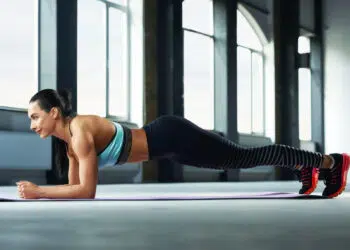Hanging knee raises are an old-school abs exercise. You can do them using a pull-up bar, but that means you need a really strong grip. Alternatively, you can use a captain’s chair. Both options deliver an effective workout for your abs.
But what if your grip isn’t strong enough, you don’t have a captain’s chair, or you’ve done this exercise before and want to try something else?
The good news is that there are plenty of hanging knee raise alternatives that are just as effective. In this article, we reveal 12 of the best.
Hanging Knee Raise Anatomy
Hanging knee raises are a core exercise, and core is the collective term for the muscles of your midsection. This exercise primarily works the anterior core, i.e., the muscles on the front of your abdomen. That said, some variations target the obliques, and a few other muscles are also involved.
The main muscles trained during hanging knee raises are:

Level Up Your Fitness: Join our 💪 strong community in Fitness Volt Newsletter. Get daily inspiration, expert-backed workouts, nutrition tips, the latest in strength sports, and the support you need to reach your goals. Subscribe for free!
Rectus abdominus
Located on the front of your abdomen, the rectus abdominus flexes your spine and also plays a part in lateral flexion. If you are lean enough, this is the muscle that gives you a six-pack. Most people do hanging knee raises to build a stronger rectus abdominus.
Transverse abdominus
Known as the TVA for short, this muscle encircles your abdomen like a weightlifting belt. When engaged, it contracts inward to increase intra-abdominal pressure to support and stabilize your spine.
Obliques
Located on the side of your abdomen, the obliques act as stabilizers during regular hanging knee raises. However, if you add a twist, oblique activation increases. The obliques are basically your waist muscles.
Psoas major and iliacus
Collectively known as the iliopsoas or the hip flexors, these muscles are responsible for lifting your legs during hanging knee raises.
Forearms
While it’s unlikely that anyone does hanging knee raises to strengthen their forearms, this is a likely outcome from doing this exercise. Hanging from the bar as you work your abs will invariably build a firmer grip. However, your grip can also be a limiting factor if your hands fail before your abs. This problem disappears when you use a captain’s chair, where your forearms support your weight.
Top Hanging Knee Raise Substitutes & Alternatives
Whether you are bored of hanging leg raises or no longer find them challenging, there are plenty of exercises you can do instead.
Here are 12 of the best hanging knee raise alternatives.
1. Hanging straight leg raise
Hanging straight leg raises are a step up from hanging knee raises. With your legs extended, the levers are longer, so your muscles will have to work harder. If hanging knee raises are no longer challenging enough, this could be the next exercise to try. That said, as well as working your abs harder, this variation also increases hip flexor activation.
Learn how to do hanging leg raises here.
2. Toes to bar
Toes to bar are a gymnastic and CrossFit core exercise. They’re a lot like hanging leg raises but, instead of lifting your legs up to parallel, you raise them all the way up until your toes touch the bar. Needless to say, this increase in range of motion makes them much more challenging.
How to do it:
- Hang from a pull-up bar with an overhand, shoulder-width grip. Pull your shoulders down and back. Brace your core.
- Keeping your legs straight, flex your hips, and lift your legs. Lean back and press forward with your arms. Raise your feet until they make contact with the bar between your hands.
- Lower your legs under control and repeat.
Related: Best Abs Exercises to Build Core Strength for CrossFit
3. Front lever raise
Front lever raises are an advanced calisthenic abs exercise. If you can do hanging leg raises reasonably comfortably, this exercise is a logical progression. As well as working your abs, front lever raises will also develop stronger lats.
How to do it:
- Hang from a pull-up bar with an overhand, shoulder-width grip. Your arms and legs should be straight. Brace your core, and pull your shoulders down and back.
- Lean back, and simultaneously push your arms forward to raise your legs. Keep your body straight.
- Lift your legs to parallel to the floor or, if you prefer, until you are fully inverted. The inverted version may be slightly easier as you get a brief rest between reps.
- Lower your legs smoothly and under control and repeat.
- Each rep should start from a dead hang; swinging (kipping) is not allowed! Your arms, legs, and hips should remain straight during front lever raises.
Read more about front lever raises, including progressions and alternatives here.
4. Stability ball reverse crunch
No pull-up bar to hang from? No problem! You can get a similar abs workout using a stability ball. Of course, you CAN do leg raises on the floor, but this stability ball version is much more challenging and probably more comfortable too!
Level Up Your Fitness: Join our 💪 strong community in Fitness Volt Newsletter. Get daily inspiration, expert-backed workouts, nutrition tips, the latest in strength sports, and the support you need to reach your goals. Subscribe for free!
How to do it:
- Sit on your stability ball. Lean back and walk your feet forward until the ball fills the curve of your lower back. Hold onto a sturdy anchor behind your head, such as a squat rack.
- Exhale and contract your abs, lifting your feet off the floor. Curl your hips up toward your shoulders.
- Smoothly lower your legs and repeat.
- Make this exercise harder by a) moving more slowly or b) holding a weight between your feet.
5. Dragon flag
If you’ve ever watched a Bruce Lee or Rocky movie, you’ve probably seen the protagonist doing this cool-looking core exercise. Like hanging knee raises, this move involves lifting your legs. However, you’ll need to use your abs to support your entire body, making it a real core killer!
How to do it:
- Lie on your back on the floor. Grip an anchor behind your head to keep your upper body stable.
- Raise your legs so that they’re vertical and your weight is on your upper back and head only. Brace your abs and lock your legs straight.
- Keeping your body and legs as straight as possible, lower yourself down until your feet are just a few inches from the floor. Your legs, butt, and back should NOT touch down.
- Pull yourself back up to the vertical and repeat.
- This exercise can also be done with your legs bent – a tuck dragon flag – which is considerably easier.
6. Rollout
The rollout is a total core exercise. It works the same muscles as hanging knee raises and also gives your lats and triceps a good workout. You can do rollouts using an abs roller, barbell, TRX, or sliders. Beginners and intermediates can do kneeling rollouts, while more advanced exercises can do rollouts from standing.
Find out more about this effective core exercise here.
7. Hollow hold
Hollow holds don’t look much like hanging knee raises, but they actually work many of the same muscles. They’re a good exercise for progressing to hanging straight leg raises and toes to bar.
As an added benefit, you can do this exercise anywhere; no extra equipment is required. Hollow holds are a gymnastic and CrossFit core training staple.
How to do it:
- Lie on your back and extend your arms overhead so your biceps are next to your ears. Straighten your legs and point your toes, knees, and feet pressed together.
- Brace your core by drawing your ribs toward your pelvis and flexing your abs. Inhale and draw air down into your abdomen. You should feel your entire midsection solidify and become rigid.
- Lift your feet, legs, shoulders, head, and arms off the floor and press your lower back into the ground. The only point of contact should be your lumbar spine, which is roughly the lower third of your spine, from the tailbone to the mid-back area. Look down your body to your feet; do not tuck your chin into your chest.
- Hold for just a few seconds and then relax, working up to longer holds as you get stronger.
8. Hollow rock
The hollow rock is a more dynamic version of hollow holds. With this exercise, you shift your weight and rock along your lower back, transferring your weight from the upper part of your core to the lower. This isn’t necessarily a better exercise than standard hollow rock holds. Still, it’s a little harder and provides some useful variety.
How to do it:
- Lie on your back with your arms above your head, biceps next to your ears, and legs straight. Point your toes and squeeze your legs together.
- Brace your abs and push your lower back into the floor. Lift your legs and shoulders/arms a few inches off the floor.
- Without changing the angle of your arms or legs, rock gently while maintaining core stability. Remember to breathe; no breath-holding, please!
9. L pull-up
This exercise combines pull-ups with hanging leg raises to test and develop upper body and abs strength simultaneously. During this exercise, you use your core and hip flexors to lift and hold your legs up while doing pull-ups or chin-ups to work your lats and biceps. This is a challenging exercise but also very rewarding.
How to do it:
- Hang from your pull-up bar using a shoulder-width overhand grip (pull-up) or a narrower than shoulder-width underhand grip (chin-ups). You can also do this exercise using a neutral (palms inward) grip if your pull-up bar has the appropriate handles.
- Pull your shoulders down and back. Brace your abs and lift your straight legs up until they are parallel to the ground.
- Bend your arms and, without lowering your legs, pull your chin up and over the bar. Slowly and smoothly extend your arms and repeat.
- If you find it too challenging to keep your legs up, lower and then raise your legs between pull-ups. You can also do this exercise with bent knees.
10. Cable double crunch
You don’t need a pull-up bar or captain’s chair to work your abs. In fact, this exercise works your abs using a very similar movement but using a cable machine for resistance. Because your grip is not a limiting factor, you’re free to focus on working your abs as hard as you like. Also, you can adjust the weight to match your current core strength.
How to do it:
- Using the lowest setting on a cable crossover machine, attach a rope handle to one pully and two ankle cuffs to the other.
- Lie on the floor and attach the cuffs to your ankles and grab the rope handles with your hands. Pull the handles down and into your shoulders.
- Lift your head and shoulders off the floor, bend your legs, and bring your knees and elbows together. Pause for a second in this most-contracted position.
- Extend your arms and legs and repeat.
11. Hanging bicycle kick
This exercise is a cross between hanging knee raises and hanging leg raises. The alternating leg action creates some lateral instability, which increases oblique engagement. This is a fun alternative to hanging knee raises. Do it hanging from a bar or using a captain’s chair as preferred.
How to do it:
- Hang from your pull-up bar using an overhand, shoulder-width grip. Pull your shoulders down and back and brace your abs. Bend one leg and pull your thigh up, so it’s parallel to the floor. This is your starting position.
- Extend your bent leg forward and lower it as you simultaneously bend and pull your other leg up.
- Continue this cycling action for the required number of reps.
- Increase biceps and lats engagement by bending your arms and pulling yourself part-way up.
12. V-up
Like hanging knee raises, this exercise works your abs and hip flexors simultaneously. Also known as a V-sit, you do this exercise with straight legs, making it quite challenging. That said, you can also do it with bent legs if you need an easier workout.
How to do it:
- Lie on the floor with your legs straight and arms extended over your head, biceps next to your ears. Brace your abs.
- Raise your legs and sit up simultaneously, reaching up with your hands to touch your feet. At the mid-point of each rep, you should be balancing on your butt/lower back.
- Lie back down and repeat.
- Can’t reach your toes? That’s okay; just touch your shins instead.
More Abs & Core Exercises:
- Cable Crunch Alternatives
- Barbell Exercises For Abs
- Russian Twists
- Best Oblique Exercises
- Bear Crawl Exercise
- Jump Rope Guide
- Calisthenics Abs Workouts
More Alternative Exercises:
- Best Box Jump Alternatives
- Best Alternatives to Lunges for Bad Knees
- Crunches and Sit-Up Alternative
- Triceps Pushdown Alternatives
- Seated Cable Row Alternative
- Romanian Deadlift Alternatives
- Cable Crossover Alternatives
- Hip Thrust Alternatives
- Back Extension Alternatives
- Leg Extension Alternatives
- Leg Curl Alternatives
- Bench Press Alternatives
Wrapping Up
Hanging leg raises are a highly effective abs exercise. Lifting your legs provides plenty of overload for your rectus abdominus, making them more challenging than things like sit-ups and crunches. But you’ll need a pull-up bar or captain’s chair to do them, and if you use this exercise too often, it could become less effective.
Avoid both these problems by doing any of these 12 hanging knee raise alternatives instead. Each one is just as effective but also different enough to provide your abs with the variation they need to continue getting stronger.
Interested in measuring your progress? Check out our strength standards for Bench Press, Cable Crunch, Sit Ups, and more.








